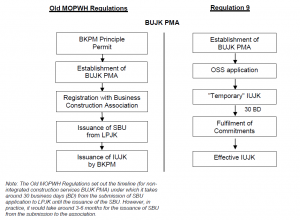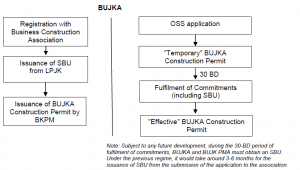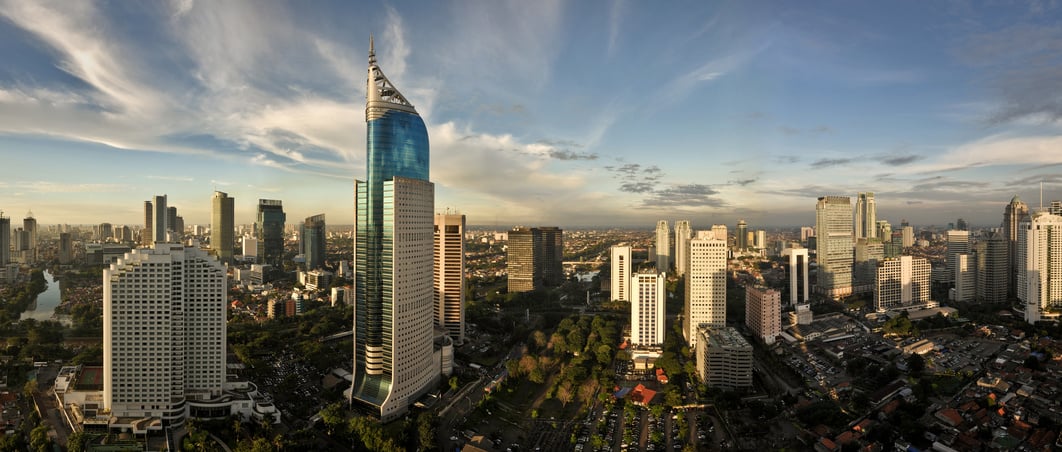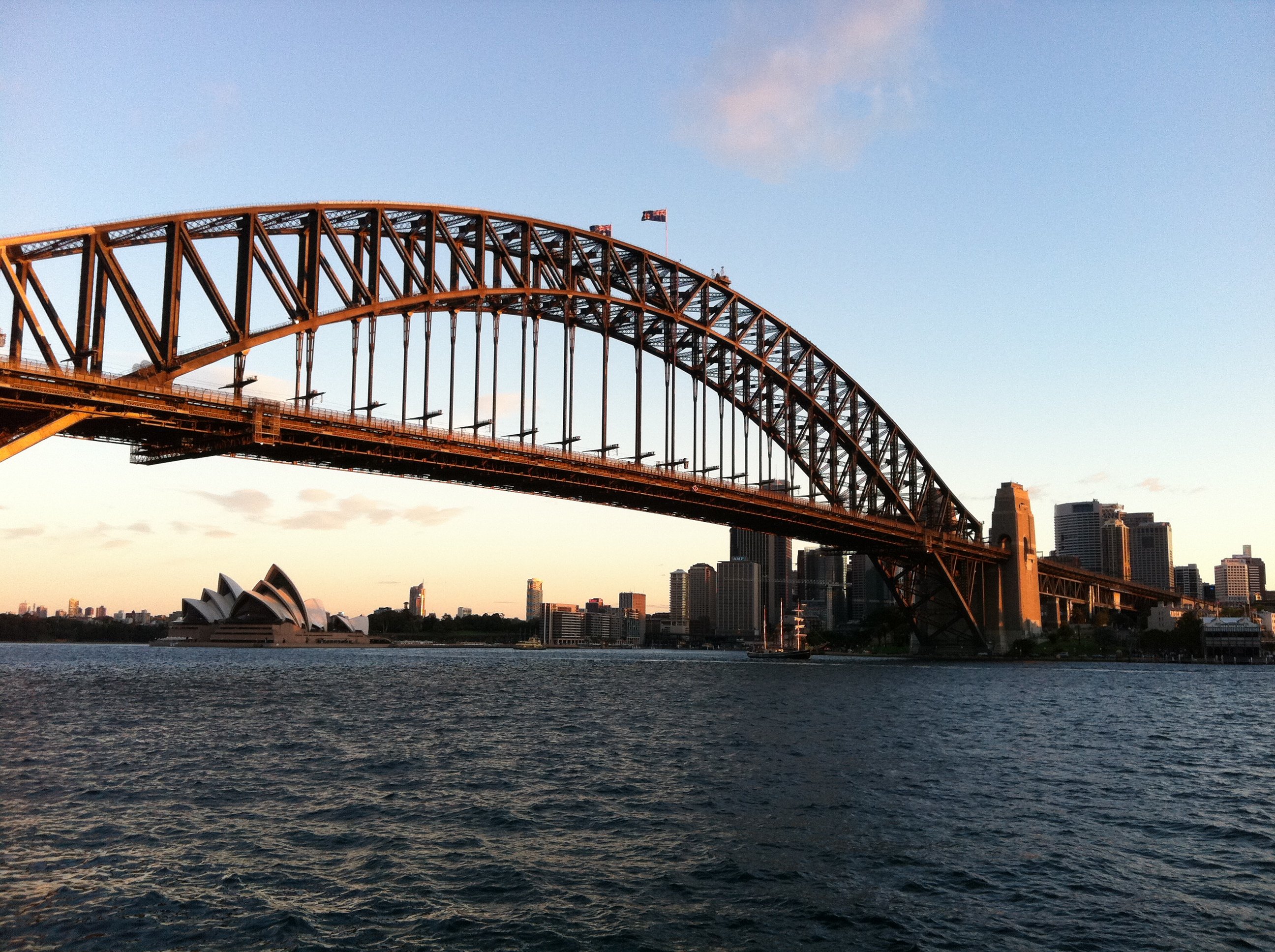A new Minister of Public Works and Housing (“MOPWH“) regulation, Regulation No. 9 of 2019 on Guidelines for Foreign Construction Services Business Entities (“Regulation 9“), came into force on 13 June 2019. Like previous regulations on similar subjects, Regulation 9 requires foreign contractors to engage as their business partners 100% Indonesian-owned local construction companies.
Overview on Foreign Contractors in Indonesia
As a general rule, a foreign contractor can operate in Indonesia through either:
(a) a joint venture company – in the form of foreign investment construction company (“BUJK PMA“) with an Indonesian local partner
(b) a representative office (“BUJKA“), i.e., by establishing a BUJKA in Indonesia and forming a joint operation/consortium with a local construction company to implement a particular project
Under the previous regulations, the Indonesian local partner in both the BUJKA and BUJK PMA structures was generally required to be a 100% Indonesianowned construction company (except for certain exemptions applicable to BUJKAs). In addition, BUJKAs were only allowed to do work that fulfilled the cumulative criteria of requiring advanced technology, and being high risk and high value.
Regulation 9 revoked the previous regulations, i.e., MOPWH Regulations No. 10/PRT/M/2014 (for BUJKA) and No. 03/PRT/M/2016 as amended (for BUJK PMA) (“Old MOPWH Regulations“). However, the general rule above is still applicable.
What’s New?
Licenses Issuance System and Sequence
Since the introduction of the Online Single Submission (“OSS“) system regulatory framework in 2018, the main construction permits for BUJKA and BUJK PMA are issued through the OSS instead of by the Investment Coordinating Board (“BKPM“), and are subject to subsequent compliance audits. Accordingly, Regulation 9 also revoked the delegation of construction permits issuance from MOPWH to BKPM, which was set out in MOPWH Regulation No. 22/PRT/M/2014. However, the OSS system is currently maintained by BKPM.
Similar to other licenses issued through OSS, construction permits for BUJKA and BUJK PMA can be issued immediately, but they will only be effective once certain commitments are fulfilled. See our previous client alert on the OSS system here.
In the past, BUJKAs and BUJK PMAs first had to secure membership in a construction association and secure a Business Entity Certificate (“SBU“) from the National Construction Development Institution (“LPJK“) before they could apply for construction permits. This process could take more than a month.
Under Regulation 9, BUJKA and BUJK PMA now first obtain a Business Identity Number (“NIB“) from the OSS system followed by a “temporary” BUJKA or BUJK PMA construction permit. They must then fulfill certain commitments within 30 days after the issuance of the “temporary” permit before they can obtain the effective BUJKA or PMA construction permits. The main commitment to be fulfilled is obtaining the SBU from LPJK. If the BUJKA or BUJK PMA fails to fulfill those commitments before the deadline, the “temporary” permit will be cancelled. Presumably the company can re-apply for the license by going through the same process. However, given the relatively short timeframe for obtaining the SBU, BUJKA and BUJK PMA may need to prepare to register with an association and to apply for the SBU application before processing the “temporary” permit in order to meet the 30-day deadline.
The fulfilment of the commitments is currently carried out manually (by email to MOPWH) until an online system (which is expected to be integrated with the OSS, annual report and work registry system) is launched.
Once issued, a BUJKA permit is valid for three years. A PMA permit will be valid as long as the holder continues to operate (note that an SBU typically must be renewed every three years).
Please refer to:
- Appendix A for a comparison of the licensing procedures under the Old MOPWH Regulations and the current licensing issuance system under Regulation 9.
- Appendix B for a list of commitments that need to be fulfilled by a BUJKA and BUJK PMA to obtain the effective BUJKA and PMA permit. Note that the list of commitments may change from time to time, at MOPWH’s discretion. Regulation 9 only specifically mentions getting the SBU as a commitment that needs to be fulfilled.
At Least One Project within Three Years
Under Regulation 9, both BUJKA and BUJK PMA must carry out at least one construction project within a three-year period (i.e., during the validity period of the BUJKA permit and the SBU). If they fail to do so, the BUJKA and PMA permit can be revoked. If the permit is revoked, the company can only apply for a new license at the earliest five years after the revocation.
It remains to be seen how strictly the authorities will enforce this requirement, and whether a dispensation may be given to BUJKAs and BUJK PMAs that are unable to get any project within the three-year period.
Criteria for Local Partners
BUJKA
Similar to requirements in the Old MOPWH Regulations, a BUJKA can only form a joint operation with 100% Indonesian-owned construction companies (“BUJKN“) that are qualified as “large”. However, the Old MOPWH Regulations provided some leeway on this. If the 100% local ownership requirement could not be fulfilled, the BUJKA was permitted to form a joint operation with a majority (65%) Indonesian owned BUJK PMA subject to approval from the MOPWH.
Regulation 9 does not provide the same exemption. Hence, local partners must be 100% Indonesian-owned construction companies.
Regulation 9 also stipulates the following:
(a) A joint operation is formed by one BUJKA with one or more BUJKN.
(b) The local partner(s) must have the same business activities/provide the same services as the BUJKA.
BUJK PMA
Similar to the Old MOPWH Regulations, the local shareholder(s) in a BUJK PMA must be 100% Indonesian-owned construction companies. Regulation 9 also requires the local shareholder(s) to be qualified as “large” and to hold the same classification as the BUJKA.
Under Regulation 9, in order to obtain an “effective” PMA permit, a BUJK PMA must submit documents evidencing that at least 33% of the shares in the company are owned by an Indonesian company (30% if the foreign shareholder is from an ASEAN country). This is in line with the foreign shareholding limitation under the current Negative List.
Before 2007, the construction business line was 100% open for foreign investment. A number of BUJK PMA have maintained this higher foreign ownership until now, under the grandfathering principle in the Negative List. It remains to be seen whether the MOPWH will also require existing PMA companies with more than 67% foreign ownership to comply with the above shareholding requirements when they apply for an extension of their BUJK PMA licenses.
Criteria of Work
Under the Old MOPWH Regulations, BUJKAs were only allowed to do construction work that fulfilled the cumulative criteria of: requiring advanced technology, and being high risk and high value. High value was defined as construction work having a minimum construction value of IDR 100 billion (for construction execution work) or IDR 10 billion (for construction consultancy work).
Unlike the BUJKA, BUJK PMA may perform construction work that fulfills any of the above criteria (i.e. – these are alternative criteria). However, the Old MOPWH Regulations do not define “high value” but refer instead to the applicable regulations. Under the Negative List, the minimum value of construction work that can be done by a BUJK PMA is work with a value of more than IDR 50 billion (for construction execution work) or more than IDR 10 billion (for construction consultancy work).
Regulation 9 seems to align the work criteria for BUJKA and BUJK PMA with the Construction Law and Negative List, i.e., the work must require advanced technology, be high risk and/or high value. But, unlike the Old MOPWH Regulations for BUJKA, it does not provide a specific definition as to what constitutes “high risk”, “advanced technology” or “high value”.
Specifically for a JO between a BUJKA and a BUJKN, the work distribution requirements remain the same, i.e.,:
- For construction execution work: at least 50% of the work value must be performed onshore and at least 30% of the work value must be performed by the BUJKN.
- For construction consultancy work: all work must be performed onshore and at least 50% of the work value must be performed by the BUJKN.
Non-Indonesian Citizen as the Chief Representative (“PJBU”) in BUJKA?
The Construction Law issued in early 2017 introduced a new requirement for the position of PJBU in a BUJKA to be filled by an Indonesian citizen. This requirement does not apply to BUJK PMA.
Regulation 9 seems to provide some leeway on this requirement, so that if no Indonesian citizen fulfills the requirements to become a PJBU set out in the ministerial regulation, a foreign citizen may be appointed as the PJBU, but an Indonesian citizen must then be appointed as the technical-person-in-charge (“PJTBU“). Presumably the detailed criteria for PJBU will be set out in a separate regulation.
Unlike Regulation 9, the Construction Law does not provide any exemption/leeway from the obligation to have an Indonesian citizen as a PJBU. Accordingly, the provisions of Regulation 9 that allow non-Indonesian citizens would seem to contradict the Construction Law.
Harsher Sanctions for Violations and Delays in Applying for Extension of Construction Permit
Regulation 9 sets out various administrative sanctions for violations of its provisions, which include written warnings, fines, temporary suspension, inclusion on a blacklist, business license suspension and business license revocation. The blacklist sanction is new. Once included in the blacklist maintained by MOPWH, BUJK or BUJK PMA will remain on the blacklist for three years and will not be allowed to perform construction activities until the end of that period – by which point, presumably, their construction licenses would have expired.
BUJKA and BUJK PMA also need to ensure that they:
(a) submit periodical report to the MOPWH on time, which contains, among other things: (i) information on ongoing construction service work, (ii) audited financial statements and (iii) copies of SBUs of the JO partner and subcontractors
(b) apply for an extension of the construction permit by the deadline prior to the expiry of the permit
Failure to fulfill the above obligations on time may lead to the company being blacklisted and its construction permit being revoked. If the permit is revoked, BUJKA and BUJK PMA will only be able to apply for a new permit at the earliest five years after the revocation. This is a significantly longer period than that under the Old MOPWH Regulations, which stated that BUJKA and BUJK PMA can apply for a new construction permit at the earliest three years after the revocation of the previous permit.
Closing
We expect that LPJK will soon issue new guidelines for the issuance of SBU to bring them in line with Regulation 9. In the meantime, the current minimum capitalization and other technical requirements under the current LPJK regulations are still applicable.
The main thrust of the changes introduced by Regulation 9 seems to be to tighten up the requirements for foreign contractors, and to give Indonesian contractors a bigger role. Ironically, by stipulating that the Indonesian partners for the BUJKA/BUJK PMA must have the same services/business activities as their foreign counterpart, there will be fewer options for foreign contractors when selecting their local partners.
Appendix A
COMPARISON BETWEEN LICENSING PROCEDURES UNDER THE OLD MOPWH REGULATIONS AND REGULATION 9


Appendix B
LIST OF COMMITMENTS TO OBTAIN EFFECTIVE CONSTRUCTION PERMIT FOR BUJKA AND BUJK PMA
Applicable to BUJKA
- Application letter to MOPWH c.q. General Director of Construction
- NIB and “temporary” BUJKA construction permit issued by OSS
- Valid SBU issued by LPJK
- Statement letter stating that PJBU and PJTBU will not hold dual positions as directors, commissioners, PJBU and PJTBU in BUJK PMAs, BUJKNs and other BUJKAs at the same time
- For PJBU and PTJBU:
(a) limited/permanent stay permit, passport or Indonesian ID card
(b) letter of appointment from the parent company of BUJKA
Applicable to BUJK PMA
- Application letter to MOPWH c.q. General Director of Construction
- NIB and “temporary” BUJK PMA construction permit issued by OSS
- Valid SBU issued by LPJK
- Deed of establishment of BUJK PMA and its amendments along with the approval from the Minister of Law and Human Rights
- Articles of association of BUJKA and any amendments thereto along with the approval or receipt of notification from the Minister of Law and Human Rights
- Statement letter stating that director, commissioner, PJBU and PJTBU do not hold dual positions as directors, commissioners, PJBU and PJTBU in BUJKAs, other BUJK PMAs and BUJKNs at the same time
- Proof of identity of foreign contractor:
(a) latest annual report of the foreign contractor
(b) company profile of the foreign contractor
(c) certificate/business license demonstrating the grade of company in construction field
8. Proof of identity of BUJKN:
(a) SBU with ‘large qualification’
(b) BUJKN construction permit
Note: Documents from the origin country must use the letterhead of the foreign contractor, and must be legalized by a notary and the Indonesian Embassy of the origin country, in Indonesian or English language. Documents from Indonesia must use the letterhead of the company, chopped with stamp duty and the company’s wet stamp.
2 New Regulation on Foreign and PMA Contractors Requires Stricter Compliance and Provides Bigger Roles for Indonesian Contactors | August 2019
3 New Regulation on Foreign and PMA Contractors Requires Stricter Compliance and Provides Bigger Roles for Indonesian Contactors | August 2019
4 New Regulation on Foreign and PMA Contractors Requires Stricter Compliance and Provides Bigger Roles for Indonesian Contactors | August 2019
5 New Regulation on Foreign and PMA Contractors Requires Stricter Compliance and Provides Bigger Roles for Indonesian Contactors | August 2019
6 New Regulation on Foreign and PMA Contractors Requires Stricter Compliance and Provides Bigger Roles for Indonesian Contactors | August 2019
7 New Regulation on Foreign and PMA Contractors Requires Stricter Compliance and Provides Bigger Roles for Indonesian Contactors | August 2019



